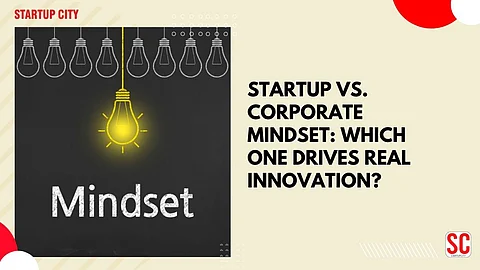

“Innovation distinguishes between a leader and a follower.”
Steve Jobs
Have you ever wondered why some companies disrupt industries while others struggle to evolve?
In my experience working with both fast-moving startups and structured corporate giants, I’ve seen two very different mindsets at play. One thrives on speed, flexibility, and daring dreams. The other relies on stability, strategy, and scale.
But here’s the million-dollar question: Which mindset truly drives real innovation — startup or corporate?
Let’s dive into a candid comparison — and you might just walk away with a blueprint for unlocking innovation in your own business.
Startups are often born out of a powerful vision — a desire to change the world, fix a broken system, or introduce something the market has never seen.
So what fuels their innovation engine?
Startups don’t have ten layers of management. Decisions are made fast, products ship faster, and feedback loops are incredibly short.
Example: Think of Swiggy or Razorpay in India. They evolved rapidly by pivoting based on real-time feedback and market demand.
Failure isn’t feared. It’s expected. In fact, startups wear it like a badge of honor — because each failure teaches them something invaluable.
“Move fast and break things.” — Mark Zuckerberg
Unlike corporates, startups don’t innovate for headlines. They innovate to survive. If they don’t solve a problem better or cheaper — they’re out.
When everyone’s voice is heard, ideas come from everywhere — not just the top.
Bottom Line? The startup mindset breeds innovation because it’s built into the DNA of the business.
On the flip side, large corporates may seem too slow or bureaucratic — but don’t write them off just yet.
There’s a reason they’ve lasted this long.
With strong balance sheets and experienced teams, corporates can invest in long-term R&D, advanced tech, and world-class talent.
Example: Tata Group or Reliance have made significant innovations in tech, sustainability, and digital transformation — because they can afford to play the long game.
Startups often fail to scale. Corporates have the opposite strength — they know how to operationalize innovation across multiple markets and products.
Corporates may move slower, but their decisions are deeply calculated. They test, iterate, and roll out innovations when ready.
Many corporates are now creating startup-like environments internally.
Example: Mahindra’s Spark the Rise or Google’s 20% Time (where employees spend time on personal innovation projects).
Bottom Line? The corporate mindset may not be as fast — but it’s far more strategic, sustainable, and scalable when harnessed right.
Factor
Startup Mindset
Corporate Mindset
Speed
Rapid execution
Structured timelines
Risk
High risk appetite
Calculated, low-risk strategy
Decision-making
Fast, intuitive
Hierarchical, data-driven
Innovation Drivers
Vision, survival, disruption
Strategy, brand longevity, customer experience
Resource Availability
Limited but scrappy
Abundant but regulated
Culture
Collaborative, flexible
Formal, goal-oriented
Here’s the secret I’ve learned…
Real innovation doesn’t live in either camp — it lives in the overlap.
The magic happens when a startup’s agility meets a corporate’s stability. When fearless creativity is combined with strategic structure.
Imagine a large company empowering internal teams to think like startups. Or a startup adopting corporate discipline as it scales.
That’s when you unlock exponential innovation.
Whether you're a startup founder or a corporate leader, here’s how you can infuse innovation into your organization:
Dedicate 10–20% of time or budget for testing new ideas — even the wild ones.
Celebrate failures that led to insights. Make it safe for your team to fail forward.
Foster cross-functional teams. Innovation happens when marketing talks to product, and finance talks to tech.
Both startups and corporates must treat customer feedback as their innovation compass.
Innovative teams are curious, passionate, and purpose-driven — more than just qualified.
Let me show you how Microsoft, once considered a bureaucratic giant, reinvented itself.
Under Satya Nadella, Microsoft adopted a startup mindset — focusing on cloud, collaboration, and customer-centricity. They embraced growth mindset culture, encouraged internal innovation, and turned around their brand and stock price dramatically.
This isn’t luck — it’s mindset.
Startups drive innovation through speed, risk-taking, and vision.
Corporates drive innovation through scale, strategy, and resources.
The real winners blend both mindsets to create a culture of unstoppable innovation.
Ask yourself:
Are you moving fast — but without structure?
Or are you structured — but slow to adapt?
What would happen if you borrowed a little from the other side?
You’re not alone if you’ve faced this internal tug-of-war. Many successful leaders are now intentionally building hybrid cultures — ones that move fast but think smart.
Innovation isn’t a choice between startup vs. corporate mindset. It’s about creating the right mindset for your mission.
As a leader, your job is to cultivate a culture where innovation thrives, regardless of your size, industry, or stage.
So whether you’re building a startup from scratch or steering a corporate ship, remember:
Innovation isn’t a department. It’s a mindset.
And the best leaders? They build both the speed of a startup and the scale of a corporation into their DNA.
Which mindset do you identify with more — and what’s stopping you from blending both?
Let’s start a conversation. Share your thoughts in the comments, or connect with us onStartup City India to explore how you can spark innovation in your business today.